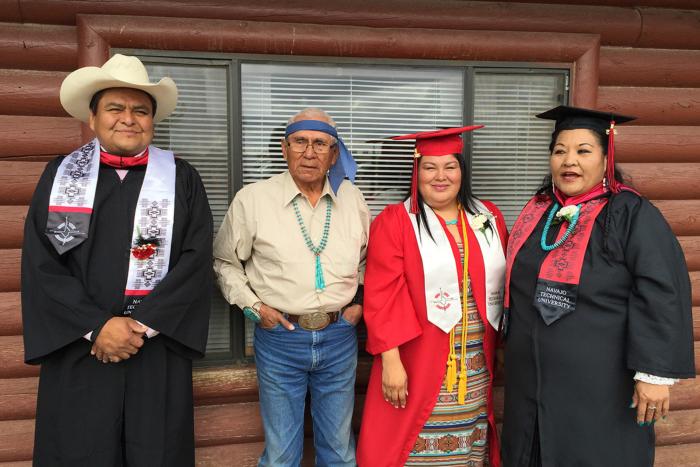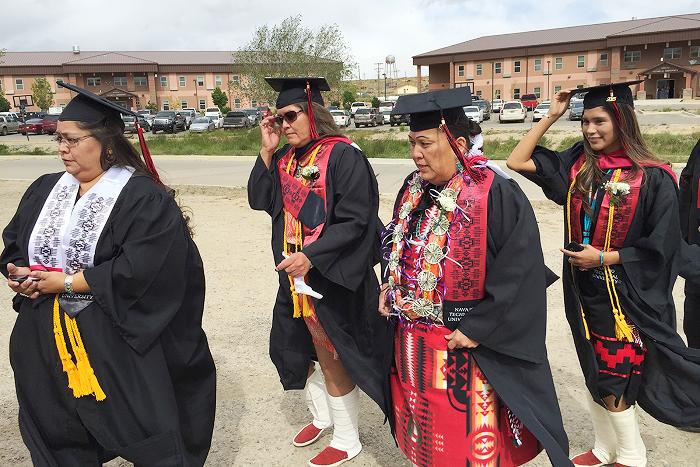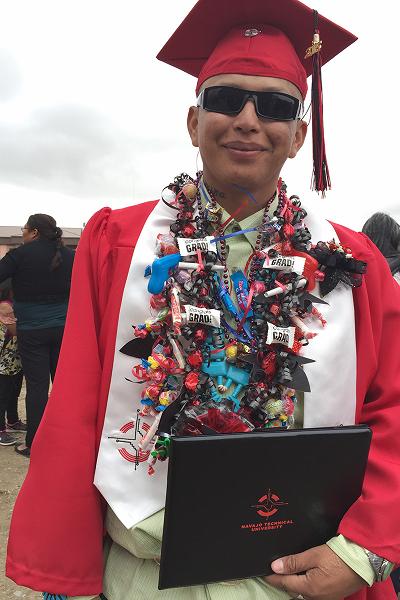 |
Canku Ota
|
 |
|
(Many Paths)
|
||
|
An Online Newsletter
Celebrating Native America
|
||
|
December 2017 - Volume
15 Number 12
|
||
|
|
||
|
Graduating In The
Navajo Way
|
||
|
by Amy Horowitz
|
||
|
credits: all photos bu
Any Horowitz)
|
|
The lands of the sovereign Navajo (Diné) Nation extend across New Mexico, Arizona, Utah, and Colorado. The nation operates under a tribal form of government, but that wasn't always the case. The fight was long, and it wasn't until 1975, with the passing of the Indian Self-Determination and Education Assistance Act, that Navajos regained the right to control their own affairs. Long threatened with cultural genocide through conquest, territorial displacement, and the establishment of the Indian Day and Boarding School Systems, which force-fed Native youth white culture and religious beliefs, the Navajo Nation now controls its own destiny. However, the damage done by a school system aiming for total assimilation endures. Since then, the establishment of tribal schools have been crucial in the Diné struggle for self-determination. Navajo Technical University (NTU), the inspiration for this short video documentary, is one of two tribal institutions of higher education on the Navajo Nation. Originally founded in 1979 as a training center to combat poverty and unemployment, the institution achieved university status in 2013 and conferred its first master's degree in 2016. Plans are now under way for a doctoral program. NTU credits this success as stemming from "our mission and our identity rooted in the Diné Philosophy of Education." In this documentary, you will meet spiritual leaders, graduates, faculty, and staff from NTU. You will witness students who are, in the words of medicine man Dan Jim Nez, "graduating in the Navajo way."
In 2015, Folklife media director Charlie Weber and I headed northwest on Interstate 40 en route to NTU in Crownpoint, New Mexico. As we drove past Grants, Mt. Taylor rose in the distance. Known to the indigenous community as Tso odzil, it is one of the Navajo Nation's four sacred mountains. Turning off at Thoreau, we headed toward the Navajo Nation border, marked by a sign: "YÁ'ÁT'ÉÉH Welcome to the Navajo Nation." Now on Bureau of Indian Affairs roads, we wound through rose-colored peaks and mesas and across the continental divide. The picturesque landscape holds many tales, including a legacy of uranium mining that studies declare will impact future generations for the next thousand years. A sign pointed east toward the ancient, sacred site of Chaco Canyon. Our trip to NTU coincided with the spring commencement ceremony. At dawn, trucks and cars had already lined up to enter the campus. The air was electric with anticipation. Graduation day enfolds individual, familial, clan, and tribal dimensions. As students, faculty, and families readied themselves for the ceremony, two centers of gravity stood out. The first was the gymnasium, where the commencement would take place. The second was across the parking lot at the hooghan, an eight-sided traditional Diné home and sacred space. On campus, it is home to the School of Diné Studies. Around the circular fire pit, graduates lined up for the procession to the gymnasium.
Dan Jim Nez led with sacred singing, followed by NTU president Dr. Elmer Guy and Jonathan Nez, vice president of the Navajo Nation. Miss NTU, Glennis Yazzie, carried the sacred medicine bundle. Students adorned themselves in localized attire, from feathered "caps" refashioned into cowboy hats to handmade moccasins—an indigenous reclamation of Diné sensibilities. Dakota Cooke performed "The Star-Spangled Banner" in the Diné language. Family members took to the stage to honor their graduates by pinning flowers to their lapels. When the ceremony concluded, families huddled around their graduates, and we made our way back to the hooghan to meet with Dr. Wesley Thomas. Thomas is a cultural anthropologist and the initiator of Diné studies and the graduate studies program at NTU. He articulated the challenges of introducing global issues in an environment where local struggles are so dire. He introduces students to Palestine, Ferguson, and South America, noting, "The students are too busy surviving on the reservation, so here I provide that for them." As Thomas explained, cultural genocide has multiple forms: the legacy of stolen lands, trauma from the Long March, toxic environmental issues, and livestock reduction, to name a few.
Professor Anita Roastingear echoed the sentiment about tension between local struggles, survival of indigenous ways, and global issues. "Native American students are vital to the global experience," she said. "We have to know the dominant society, languages, court system, educational system, but we don't have to be conquered by them." This discussion initiated our thinking about a global studies approach that centers indigenous issues. In the context of the sovereign Navajo Nation within the United States, the global is local. The GALACTIC program (Global Arts Local Arts Culture Technology International Citizenship) began to take shape that day in the hooghan. Over the next months, we co-created an annual workshop at the Smithsonian Folklife Festival and at Indiana University's Institute for Curriculum and Campus Internationalization. Our long-term goal is to develop indigenous global studies with a focus on sustainability of indigenous local languages and cultural traditions in a global era. This video documents a Diné commencement ceremony, a time of new beginnings for students who graduate "in the Navajo way." For us, it also represents the commencing of a multiyear collaboration focused on indigenous global and local cultures, art, and survival issues. Amy Horowitz is the director of GALACTIC. A longtime associate of the Center for Folklife and Cultural Heritage, she served as acting and assistant director of Smithsonian Folkways Recordings and Folklife curator in the 1990s. GALACTIC (Global Arts Local Arts Culture Technology International Citizenship) is a project of the Center for the Study of the Middle East and the Center for the Study of Global Change at Indiana University, the School of Diné Studies at Navajo Technical University, the Roadwork Center for Cultures in Disputed Territories, and the Smithsonian Center for Folklife and Cultural Heritage. |
|||||
|
|
|
|
||
|
|
||
| Canku Ota is a free Newsletter celebrating Native America, its traditions and accomplishments . We do not provide subscriber or visitor names to anyone. Some articles presented in Canku Ota may contain copyright material. We have received appropriate permissions for republishing any articles. Material appearing here is distributed without profit or monetary gain to those who have expressed an interest. This is in accordance with Title 17 U.S.C. Section 107. | ||
|
Canku Ota is a copyright ©
2000 - 2017 of Vicki Williams Barry and Paul Barry.
|
||
 |
 |
|
|
The "Canku
Ota - A Newsletter Celebrating Native America" web site and
its design is the
|
||
|
Copyright ©
1999 - 2017 of Paul C. Barry.
|
||
|
All Rights Reserved.
|
||


